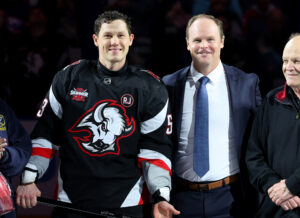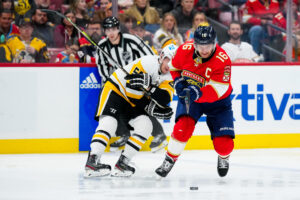The Philadelphia Flyers are not having a bad season by any means. They’re right in the thick of the competitive East Division’s battle for playoff spots. However, the Flyers’ decent record does not reflect their polarized performance thus far. Yes, they are the team that demolished the Buffalo Sabres in back-to-back 3-0 shutouts and once outscored the Washington Capitals 7-4. But they are also the team that dropped three goals to the Pittsburgh Penguins in a span of 71 seconds and lost five consecutive games against the Boston Bruins. The problem, it seems, has to do with the Flyers’ identity crisis. They don’t appear to have a defined system, which can lead to erratic, inconsistent play. In the spirit of improvement, here’s a few common styles that could solve the Flyers’ identity crisis – and some things they’d need to change to implement them.
[pickup_prop id=”3087″]
Three Possible Ways to Solve the Flyers’ Identity Crisis
Play a Shut-Down Defense
What it would look like
In last year’s Stanley Cup Playoffs, the Flyers experienced the difficulties of playing a defense-oriented team when they faced the New York Islanders. Through head coach Barry Trotz’s signature defensive system, the Islanders put the Flyers’ offense in a stranglehold. In their four victories, the Isles held the Flyers to a mere three-fourths of a goal. Additionally, their shut-down defense forced Philly to earn all three of its wins in overtime.
What would need to change
If the Flyers were to try running a Trotz-style system, they’d first have to address their turnovers. Currently, the Flyers sport a dismal -29 defensive zone turnover differential. As the Flyers have seen, frequently giving up the puck allows the opponent more possession time, more shots, and, typically, more goals. After all, it was lackadaisical turnovers that put the Flyers down three goals to the Penguins early in last Thursday’s game.
Unfortunately, though, the turnover issue is a difficult one to remedy. As nice as it would be to believe the Flyers are giving up pucks out of plain laziness, it’s more likely that they’re having problems finding the open passing lane. Or maybe they have the lanes, but for some reason just can’t execute. Either way, the turnover problem isn’t something that can be solved overnight, so the Flyers would have a lot of hard work ahead of them if they decided to pursue a defensive team identity.
Rely on a Fiery Offense
What it would look like
If morphing into a defensive system isn’t a viable option, the Flyers could go the other direction. Offensive systems typically aren’t very strong on the back end, but they find ways to win by outscoring the opponent. Take, for example, the Edmonton Oilers. The Oilers are a powerhouse on offense, with Connor McDavid and Leon Draisaitl (two of the NHL’s elite forwards) centering their first and second lines, respectively. Through 25 games, Edmonton scored an average of 3.2 goals per game, well above the league average. On the flip side, they allowed an average of 3.12 goals per game – which is also above the league average.
What would need to change
While the Flyers don’t quite possess any forwards of McDavid or Draisaitl’s caliber, they do have skilled players and highly-touted depth. They simply struggle to figure out how to put the pieces together. One group that has had great success is the Joel Farabee–Sean Couturier–James van Riemsdyk first line. Farabee’s speed and shot, Couturier’s effective two-way centering, and van Riemsdyk’s signature blue paint deflections are a formidable combination. But although the first line displays innate chemistry, the rest of the forward lines are a perplexing puzzle.
This season, Alain Vigneault has particularly struggled to place Travis Konecny, Oskar Lindblom, and Nolan Patrick. All three young forwards have been underperforming, together totaling just 24 points (that’s less than van Riemsdyk’s individual production). Granted, Lindblom and Patrick might still require some time to readjust to NHL-level play. Both were sidelined last season with major health conditions – Ewing’s sarcoma for Lindblom and a migraine disorder for Patrick. There is no such explanation, however, for Konecny’s play.
Konecny, Lindblom, and Patrick have moved up and down the lineup all season, yet no combination has sparked sustained production. Finding some way to reinvigorate them would be key to stabilizing the lines behind the first thereby building a more effective offense.
[pickup_prop id=”3584″]
Bring Back the Broad Street Bullies
What it would look like
Thanks to the legacy of the “Broad Street Bullies”, the Flyers have a history of thriving on heavy-hitting, physical play. However, today’s team tend to shy away from checks, opting instead to try to out-skate or out-pass the opponent. The problem here is that the Flyers, as mentioned before, constantly turn over the puck. They’re also not the fastest team, so they end up having difficulty getting into the offensive zone and containing opposing players in the defensive zone. Ideally, a Flyers team built around physicality would look something like the Washington Capitals. The Capitals, too, aren’t exceptionally speedy, but they create space and force turnovers through aggressive checking.
What would need to change
For the Flyers to develop an identity as a physical team, they’d have to work on getting more hits from more of their players. Through 21 games, Robert Hagg, Nicolas Aube-Kubel, and Scott Laughton led the team in hits, with 58, 55, and 54, respectively. However, there’s a large gap between their numbers and the rest of the team’s. Ivan Provorov, fourth in hits, had only 32.
In particular, the Flyers would need to see increased physicality from their bigger players. The Capitals’ hits leaders are Tom Wilson, Alex Ovechkin, and Brenden Dillon – all at least 6’2″, 200 lbs. Thus, while it’s great to see 5’11”, 187 lb Aube-Kubel checking aggressively, he simply cannot land hits as heavy as someone the size of the Capitals’ most physical players could. Defenseman Philippe Myers is 6’5″, 212 lbs, but he only recorded 22 hits. Kevin Hayes is of a similar build, and he had 23. Having the Flyers’ taller, heavier players throw their weight around as often as the team’s hits leaders would be a significant step toward developing a physical team identity.
The good news is, the Flyers’ identity crisis isn’t something that’s unsolvable. Stepping up the physicality appears to be the most realistic option, but they could implement a defensive or offensive system with a bit more effort. Cultivating an identity will certainly take time and thought, but the Flyers already have the talent and grit to make it through the transition period. And once they get things sorted out, they’ll be truly formidable.






